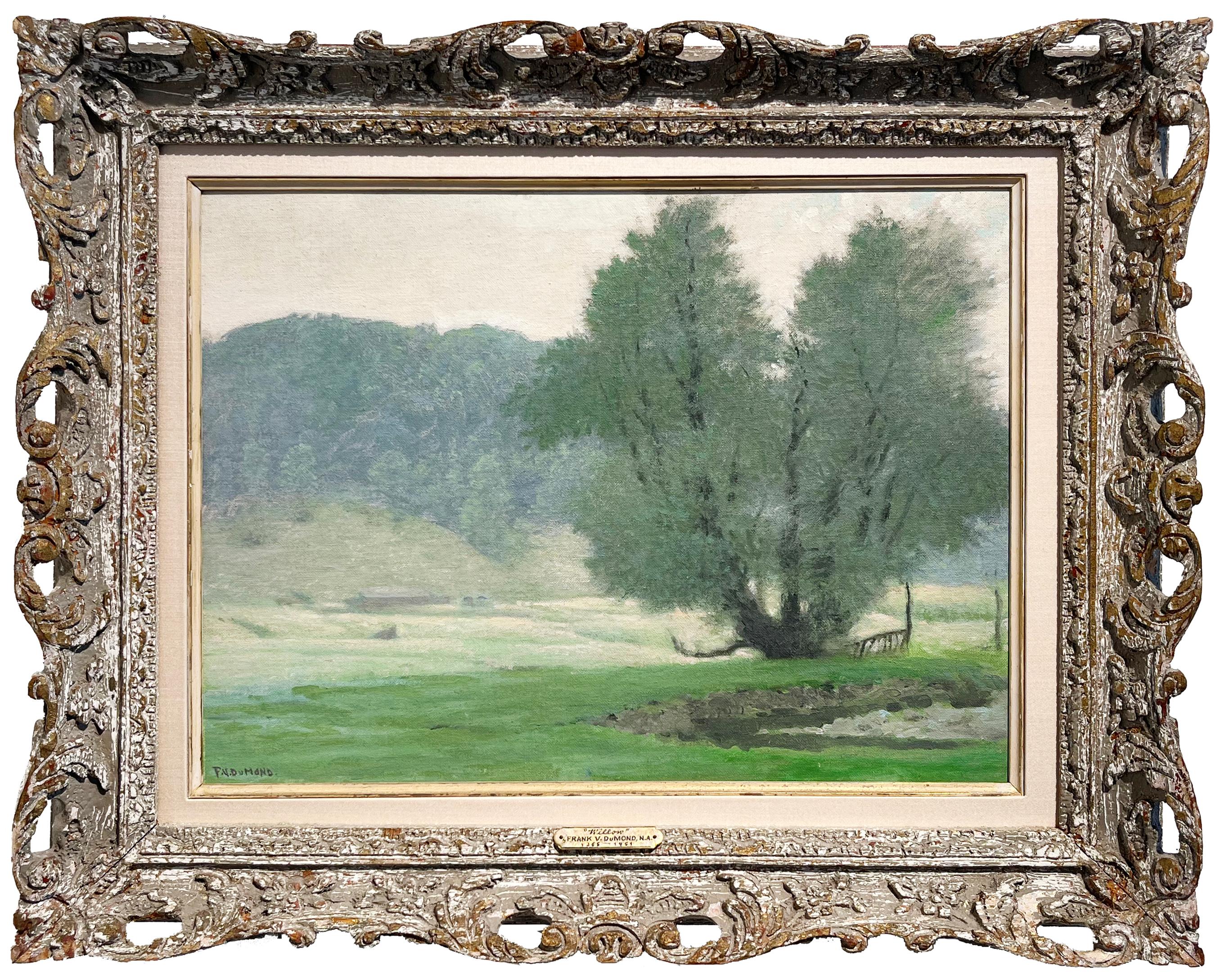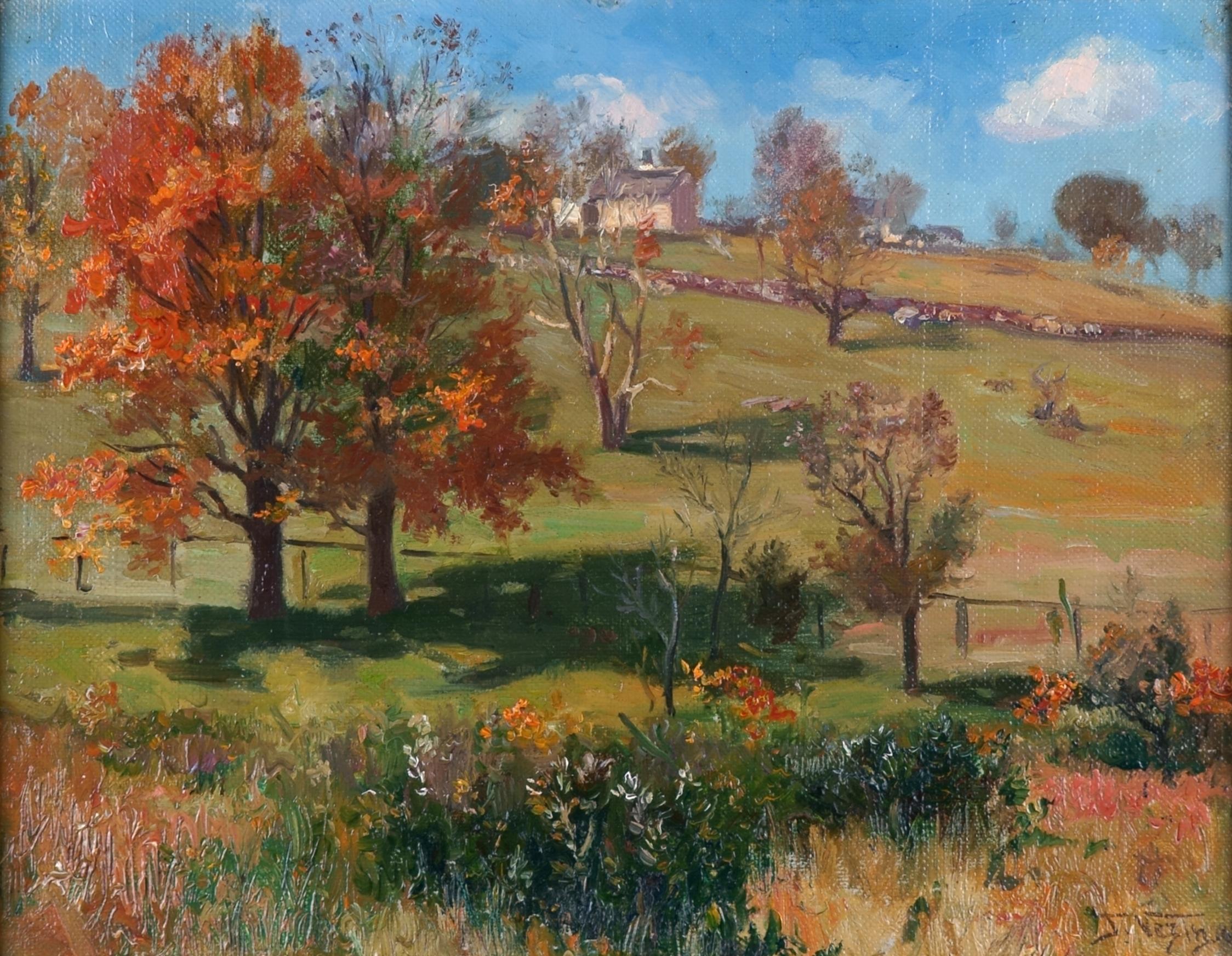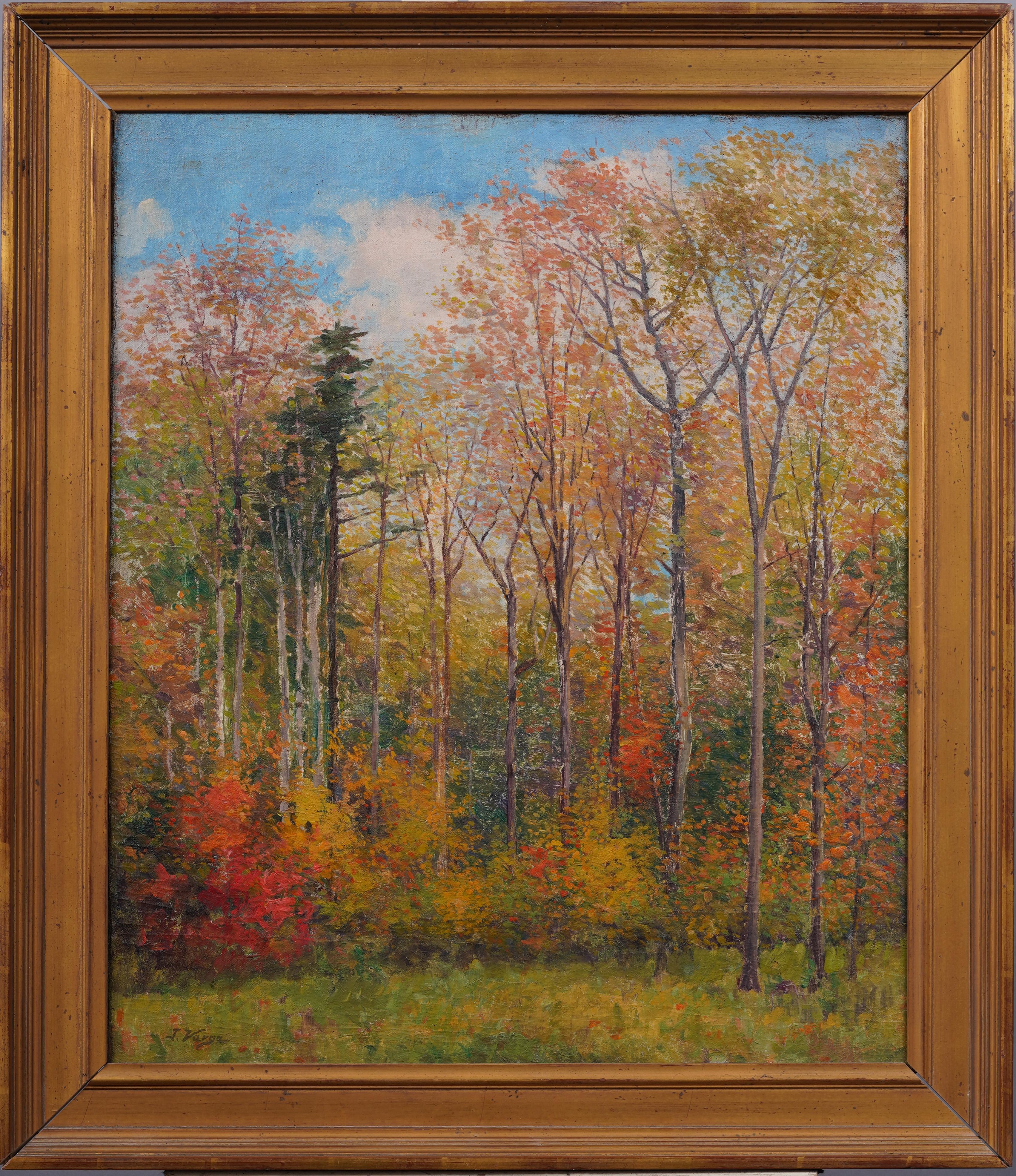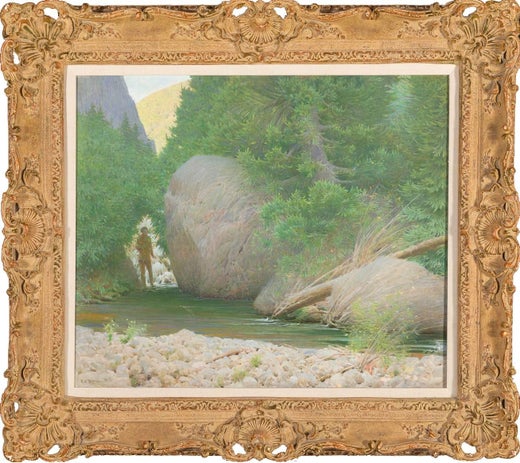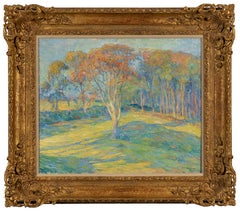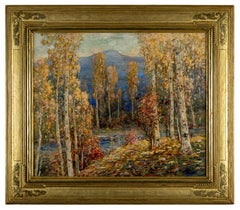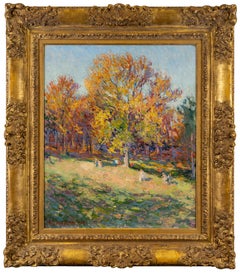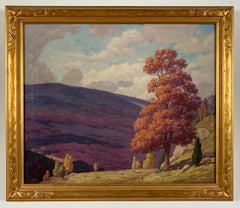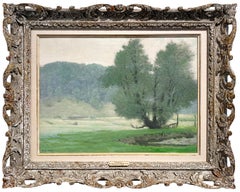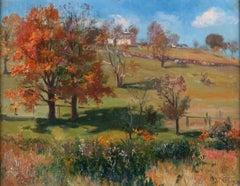Items Similar to Sunny Hedge
Want more images or videos?
Request additional images or videos from the seller
1 of 8
Frank Vincent DumondSunny Hedge1920's
1920's
$12,500
£9,520.11
€10,973.31
CA$17,487.42
A$19,654.70
CHF 10,235.65
MX$239,049.75
NOK 130,977.66
SEK 124,205.43
DKK 81,897.59
Shipping
Retrieving quote...The 1stDibs Promise:
Authenticity Guarantee,
Money-Back Guarantee,
24-Hour Cancellation
About the Item
Frank Vincent Dumond
American, 1865-1931
Sunny Hedge
Oil on canvas
Signed "F.V. DuMond," lower right
24.5 in. by 29 in. W/frame 32.5 by 37 in.
Born in Rochester, New York in 1865, Frank DuMond left his work as an illustrator at age 23 to study in the rigorous classical atelier tradition of the Academie Julian Paris in 1888. Upon his return to New York in 1892, DuMond embarked on a painting and teaching term at the Art Students League spanning nearly six decades until his death.
A painter of diverse talents, he was an accomplished landscape, portrait and still life painter, muralist, and leader of the Tonalist then Impressionist art colonies of Lyme, Connecticut. In particular, DuMond was noted for his use of landscape green. American Impressionist expert William H. Gerdts wrote of DuMond, "As one might speak of Velazquez's blacks, one must speak of DuMond's greens." Scholars have described him as a deft painter of the American Impressionist landscape and the figure, but he will perhaps be remembered as among the most outstanding educators in American art history. Though an accomplished painter, he is said to have considered himself more of an educator than an artist.
By all accounts, DuMond is described by his students as a man whose art and teaching methods were based on deeply held religious and philosophical beliefs. One student recalls, "There were occasions when DuMond revealed a clear intent to educate us on a deeper level than might casually be associated with painting." His students remember him fondly as "a genial, generous, and perceptive instructor…whose warmth and kindness pervaded everything he did." Under his tutelage, many prominent American artists were brought to recognition, including Georgia O'Keeffe, Norman Rockwell, and John Marin. Still other protégés of DuMond renown became influential teachers, such as Baroque-style painter Frank Mason, whose influence emerged in New York at the Art Students League; and Arthur Maynard and Alban Albert, whose influences emerged at the Ridgewood Art Institute to form another branch of DuMond student legacy.
It was in his early training in Paris that he absorbed the influences of his teacher Gustave Boulanger, Benjamin Constant and Jules-Joseph Lefebvre and the Barbizon and increasing popular Impressionist style. In frequent trips to the French countryside, DuMond was disciplined in painting the naturalistic landscape. Many Barbizon School landscape precepts-such as a sublime vision of the natural world, and an interest in the transient effects of light and shade to depict and dramatize it-have been handed down through generations of painters and continue to pervade art theory today.
Dumond's teaching continues to influence much of our present-day instruction. DuMond students were taught to see the progression of prismatic light flowing from yellow to red to violet on the warm side; and from yellow to green to blue-green to violet on the cool side. One student quotes DuMond as saying "Silently glowing over this whole landscape is a rainbow. You must learn to see it. It is there always, and if you can get hold of that, you have something worth going after."
Dumond's historical influence is unmistakable and nowhere is his influence more preserved than in the palette that is taught at the Ridgewood Art Institute. Variations of the palette used by DuMond-consisting of premixed blues, grays, violets and greens in tonal progression from cadmium yellow to red are still used by many instructors at the Ridgewood Art Institute and by artists around the country.
Provenance:
Private Collection, New York
Le Trianon Fine Art & Antiques, Sheffield, Ma.
Art D231
$12,500
- Creator:Frank Vincent Dumond (1865-1951, American)
- Creation Year:1920's
- Dimensions:Height: 32.5 in (82.55 cm)Width: 37 in (93.98 cm)Depth: 2 in (5.08 cm)
- Medium:
- Movement & Style:
- Period:
- Condition:
- Gallery Location:Sheffield, MA
- Reference Number:Seller: Art D2311stDibs: LU70036883532
Frank Vincent Dumond
Born in Rochester, New York in 1865, Frank DuMond left his work as an illustrator at age 23 to study in the rigorous classical atelier tradition of the Academie Julian Paris in 1888. Upon his return to New York in 1892, DuMond embarked on a painting and teaching term at the Art Students League spanning nearly six decades until his death. A painter of diverse talents, he was an accomplished landscape, portrait and still life painter, muralist, and leader of the Tonalist then Impressionist art colonies of Lyme, Connecticut. In particular, DuMond was noted for his use of landscape green. American Impressionist expert William H. Gerdts wrote of DuMond, "As one might speak of Velazquez's blacks, one must speak of DuMond's greens." Scholars have described him as a deft painter of the American Impressionist landscape and the figure, but he will perhaps be remembered as among the most outstanding educators in American art history. Though an accomplished painter, he is said to have considered himself more of an educator than an artist. By all accounts, DuMond is described by his students as a man whose art and teaching methods were based on deeply held religious and philosophical beliefs. One student recalls, "There were occasions when DuMond revealed a clear intent to educate us on a deeper level than might casually be associated with painting." His students remember him fondly as "a genial, generous, and perceptive instructor…whose warmth and kindness pervaded everything he did." Under his tutelage, many prominent American artists were brought to recognition, including Georgia O'Keeffe, Norman Rockwell, and John Marin. Still other protégés of DuMond renown became influential teachers, such as Baroque-style painter Frank Mason, whose influence emerged in New York at the Art Students League; and Arthur Maynard and Alban Albert, whose influences emerged at the Ridgewood Art Institute to form another branch of DuMond student legacy. It was in his early training in Paris that he absorbed the influences of his teacher Gustave Boulanger, Benjamin Constant and Jules-Joseph Lefebvre and the Barbizon and increasing popular Impressionist style. In frequent trips to the French countryside, DuMond was disciplined in painting the naturalistic landscape. Many Barbizon School landscape precepts-such as a sublime vision of the natural world, and an interest in the transient effects of light and shade to depict and dramatize it-have been handed down through generations of painters and continue to pervade art theory today. Dumond's teaching continues to influence much of our present-day instruction. DuMond students were taught to see the progression of prismatic light flowing from yellow to red to violet on the warm side; and from yellow to green to blue-green to violet on the cool side. Variations of the palette used by DuMond-consisting of premixed blues, grays, violets and greens in tonal progression from cadmium yellow to red are still used by many instructors at the Ridgewood Art Institute and by artists around the country.
About the Seller
4.0
Vetted Professional Seller
Every seller passes strict standards for authenticity and reliability
1stDibs seller since 2017
55 sales on 1stDibs
Typical response time: 7 hours
- ShippingRetrieving quote...Shipping from: Sheffield, MA
- Return Policy
Authenticity Guarantee
In the unlikely event there’s an issue with an item’s authenticity, contact us within 1 year for a full refund. DetailsMoney-Back Guarantee
If your item is not as described, is damaged in transit, or does not arrive, contact us within 7 days for a full refund. Details24-Hour Cancellation
You have a 24-hour grace period in which to reconsider your purchase, with no questions asked.Vetted Professional Sellers
Our world-class sellers must adhere to strict standards for service and quality, maintaining the integrity of our listings.Price-Match Guarantee
If you find that a seller listed the same item for a lower price elsewhere, we’ll match it.Trusted Global Delivery
Our best-in-class carrier network provides specialized shipping options worldwide, including custom delivery.More From This Seller
View AllSpring Landscape
By George Laurence Nelson
Located in Sheffield, MA
George Laurence Nelson
American, 1887-1978
Spring Landscape
Oil on canvas
20 ⅛ by 24 ⅛ in, w/ frame 28 by 32 in
Signed and dated 1912 lower right
George Laurence Nelson was born in...
Category
1910s Impressionist Landscape Paintings
Materials
Oil
Stony Brook, Long Island
By Paul Bernard King
Located in Sheffield, MA
Paul Bernard King
American, 1867-1947
Stony Brook, Long Island
Oil on canvas
25 ¼ by 30 ¼ in, w/ frame 34 ¼ by 39 ¼ in
Signed and titled verso
Traditional American painter Paul Kin...
Category
Early 20th Century Impressionist Landscape Paintings
Materials
Oil
Hillside in Autumn
Located in Sheffield, MA
Mary Brewster Hazelton
American, 1868-1953
Hillside in Autumn
Oil on canvas
20 by 24 in, w/ frame 29 ½ by 33 ¼ in
Signed and dated 1908 lower left
Mary Brewster Hazelton was a dist...
Category
Early 1900s Impressionist Landscape Paintings
Materials
Oil
Blue Ridge Mountains, Virginia
By Andrew Thomas Schwartz
Located in Sheffield, MA
Andrew Thomas Schwartz
American, 1867-1942
Blue Ridge Mountains, Virginia
Oil on canvas
24 by 30 in. W/frame 28 ½ by 34 ½ in.
Signed lower right...
Category
1920s Post-Impressionist Landscape Paintings
Materials
Oil
The Valley, York Maine
Located in Sheffield, MA
Alice R. Comins
American, 1861-1943
The Valley, York Maine
Oil on canvas
20 by 26 in. W/frame 27 by 33 in.
Signed lower right and dated 1913 & titled on r...
Category
1910s American Impressionist Landscape Paintings
Materials
Oil
Blue Ridge Mountains, Virginia
By Andrew Thomas Schwartz
Located in Sheffield, MA
Andrew Thomas Schwartz
American, 1867-1942
Blue Ridge Mountains, Virginia
Oil on canvas
24 by 30 in, w/ frame 28 ½ by 34 ½ in
Signed lower right
Andrew T. Schwartz was born in Loui...
Category
Early 20th Century Impressionist Landscape Paintings
Materials
Oil
You May Also Like
Willows, Old Lyme, CT Summer landscape
By Frank Vincent Dumond
Located in Greenwich, CT
A gorgeously colored summer landscape by Important American Impressionist, Frank V Dumond. Fresh in color and elegant in the tonally complimentary French frame with silk liner. Atm...
Category
1910s Impressionist Landscape Paintings
Materials
Oil, Board
Landscape
Located in San Francisco, CA
This artworl "Landscape" c. 1935 is an oil painting on hardboard by renown California artist Frank Joseph Girardin, 1856-1945. It is signed at the lower right corner. The hardboard size is 20 x 30 inches, framed size is 30.5 x 40.5 inches. Framed in a wooden beige frame, with fabric liner. It is in excellent condition.
About the artist:
Born in Louisville, Kentucky in 1856, Frank joseph Girardin began his art instruction in 1870 under Frank Noble and later Frank Duveneck at the Cincinnati Art Academy. A semi-pro baseball player in Cincinnati, he was best known for his beautiful landscapes of both Indiana and California.
An extremely active participant in the development of the Art Association of Richmond and original member of the local Sketch Club, he served on the Board of Directors of Art Association for several years. He was considered ranked next to the late John E. Bundy in talent and skill by the former Art Association Director, Mrs. Ella Bond Johnston. It was during his time in Indiana, that he received the most recognition for his work. In 1903, he won first prize for his painting, "Lingering Snow" at the Cincinnati Art Club Show. This would be one of numerous prizes and awards the he would receive during his time in Indiana, including the coveted Mary T...
Category
Mid-20th Century American Impressionist Landscape Paintings
Materials
Oil
Landscape with Trail
Located in San Francisco, CA
This artwork "Landscape with Trail" c.1930 is an oil painting on canvas by noted American artist Frederick Ernest Swedlun, AKA: Ernest Fredericks (18...
Category
Mid-20th Century American Impressionist Landscape Paintings
Materials
Oil
Autumn Landscape in Sunlight - Indian Summer -
Located in Berlin, DE
Frederick Vezin (1859 Torresdale Philadelphia - 1933 Düsseldorf), Autumn Landscape in the Sunlight, oil on canvas, mounted on cardboard, 32 x 41 cm (inside measurement), 44 x 51 cm (frame), signed and dates lower right "F. Vezin. [19]05".
- Cardboard slightly curved, small inconspicuous retouch at the centre of the upper edge of the picture.
About the artwork
Although the painting appears to be a sketch, Frederick Vezin considered it to be a finished work of art, as evidenced by his signature on the lower right. And it is precisely this sketchy quality that leads to an understanding of the painting, which was certainly created in the landscape itself: the natural phenomena were to be depicted artistically at the moment of their observation. This is not done by meticulously sketching nature, but - and here Vezin follows the teaching of French Impressionism - by illustrating nature in its visual fullness. The artist's eye is, as it were, immersed in the visuality of nature, which is made visible by his hand. The painting is therefore not a reflection of the landscape, but its artistic intensification.
This intensification also includes the fact that the foreground of the painting - corresponding to the field of vision - eludes a detail-oriented close-up view. Instead, the spatula-like application of paint, the vertical structure of which corresponds to the structure of the floral growth, has the effect of making nature tangible in its colourful substance.
At the same time, the foreground, which remains indeterminate in its concrete objectivity, creates an atmospheric space that connects with the actual protagonist of the picture, the group of trees, which flares up in shades of red and brown. Here, too, the leaves are more speckled than clearly outlined. It is precisely this 'sketchiness' that opens up a visual experience that makes the landscape accessible in its visual fullness, thus revealing its essence.
In addition to this abundance, the landscape is presented as a structure of order in that the composition of the picture makes the composition of the landscape visible. For example, the group of trees forms a distinct dark green shadow, which is repeated in the shadows cast by the trees behind it. A patterned diagonal axis is created in the picture, which is composed in this way by the landscape itself.
Strictly speaking, this is a cultivated landscape: a fence at the bottom and a low stone wall at the top, running from left to right, are two elements that also have a strong compositional effect. And on the top of the hill, a stone house is embedded in the landscape as the brightest surface in the picture. Nature and culture here form a harmonious synthesis, giving the painting an Arcadian touch.
In order to give the landscape as much space as possible, the horizon line is raised, but the design of the sky is also crucial. The clouds, combined with the shapes of the trees, create a bright blue sky. To the European eye, such a sky is reminiscent of a summer landscape. Accordingly, within the seasonal cycle, the blue sky is reserved for summer, and French Impressionism is also primarily an ode to summer. In Vezin's painting, however, the brilliant blue sky stands above an autumnal landscape, some of the trees even defoliated. It can therefore be assumed that the painting was made not in Europe but in the United States, and that it illustrates the proverbial Indian summer, making Frederick Vezin a pioneer of American landscape painting.
About the artist
Frederick Vezin was the son of a French immigrant to the United States and a German-born mother. This predestined him to promote artistic exchange between the old and new worlds. Having spent part of his schooling in Germany, in 1876, at the age of 20, he enrolled at the Düsseldorf Academy of Art, where he studied with Peter Janssen the Elder, Eduard von Gebhardt and Wilhelm Sohn, among others. He graduated in 1883, settled in Munich and returned to Düsseldorf in 1895, where he lived until his death in 1933.
A native of the United States, he travelled to the country frequently and became a popular portrait and society painter. His artistic talent, however, was most evident in his landscape paintings. Trained in French Impressionism, he developed a virtuoso use of colour and a free brushwork that remained tied to the landscape motif, opening up the landscape itself in a new way. Frederick Vezin turned his attention primarily to the landscape of his homeland, becoming a pioneer of modern American landscape...
Category
Early 1900s Impressionist Landscape Paintings
Materials
Cardboard, Oil
$2,085 Sale Price
20% Off
Antique American Impressionist Upstate New York Regionalist Landscape Painting
Located in Buffalo, NY
Antique American impressionist landscape oil painting. Oil on canvas. Signed. Framed. Measuring 27 by 31 inches overall and 21.5 by 26 painting alone.
Category
1890s Impressionist Landscape Paintings
Materials
Canvas, Oil
Landscape with Trees
By Don Langford
Located in San Francisco, CA
This artwork "Landscape with Trees" c.1970 is an oil painting on canvas by American artist Don Langford. It is signed at the lower right corner b...
Category
Late 20th Century American Impressionist Landscape Paintings
Materials
Oil
